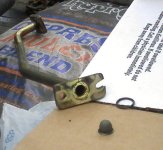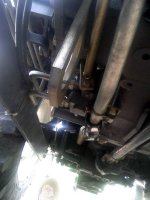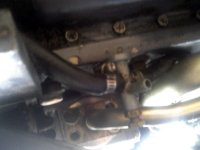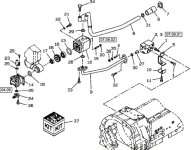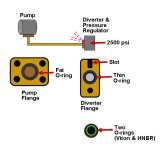jinman
Rest in Peace
- Joined
- Feb 23, 2001
- Messages
- 21,008
- Location
- Texas - Wise County - Sunset
- Tractor
- NHTC45D, NH LB75B, Ford Jubilee
I've had great luck with the hydraulics on my 2000 model TC45D and had no problems until recently. Last year, I had my hydraulic pump seals replaced on my tractor and all went back together nicely except for one pinched o-ring I had to replace at the diverter valve. About 3 months ago, I developed a spewing hydraulic leak where the high pressure line bolts to the diverter valve. That's directly under the right foot rest of the operator's platform. The leak was so bad that the whole bottom of my tractor had a hydraulic bath. I had measured my pressure at exactly 2500 psi, so I know the pressure is not too high. I figured I had not tightened the fitting properly. When I removed the nut, I found that it and its lock washer seemed to not tighten the flange properly. Below are some photos that show the flange, o-ring and screen. Notice that the pipe is made to slide straight upwards between the hydraulic pump and diverter because you cannot move the pipe horizontally to get it out. That's why there is a slot on the top of the flange. It has to slide onto a stud and then a nut added. The bottom uses a bolt. I've included some photos of the pipe installed.
On the hydraulic pump end, the flange has four bolt holes. If you look at the illustration below (Item #9) it shows the pipe has only two bolts on the flange and the diverter end does not show the slot. I found by research that the TC35D's hydraulic pump flange only has two bolts. With its pressure being only 2300 psi, only two bolts are required in the pump. I have never had a problem with the pump flange and seal leaking, only the diverter valve flange. The tiny o-ring on the diverter end just seems to blow out and spew hydraulic fluid. It's frustrating to me because it was never a problem for almost 12 years and 1700 hours. Now, a "simple" job has turned out to not be so simple.
After replacing the o-ring AGAIN, I put a flat washer under the bolt head to help apply pressure. I think the slot may have deformed or the bolt head and lock washer could not apply even pressure, allowing the flange to move outward enough to blow the seal.
After repair, I went to work boxblading my dam and moving some rip-rap with the loader. A whiff of hydraulic fluid told me to look down and my heart sank. It was spewing. Obviously, I've bent the pipe or flange so much that with the normal hardware and o-ring, sealing is NOT possible. So it's time to go to Plan B on getting the seal as it should be.
On the hydraulic pump end, the flange has four bolt holes. If you look at the illustration below (Item #9) it shows the pipe has only two bolts on the flange and the diverter end does not show the slot. I found by research that the TC35D's hydraulic pump flange only has two bolts. With its pressure being only 2300 psi, only two bolts are required in the pump. I have never had a problem with the pump flange and seal leaking, only the diverter valve flange. The tiny o-ring on the diverter end just seems to blow out and spew hydraulic fluid. It's frustrating to me because it was never a problem for almost 12 years and 1700 hours. Now, a "simple" job has turned out to not be so simple.
After replacing the o-ring AGAIN, I put a flat washer under the bolt head to help apply pressure. I think the slot may have deformed or the bolt head and lock washer could not apply even pressure, allowing the flange to move outward enough to blow the seal.
After repair, I went to work boxblading my dam and moving some rip-rap with the loader. A whiff of hydraulic fluid told me to look down and my heart sank. It was spewing. Obviously, I've bent the pipe or flange so much that with the normal hardware and o-ring, sealing is NOT possible. So it's time to go to Plan B on getting the seal as it should be.
